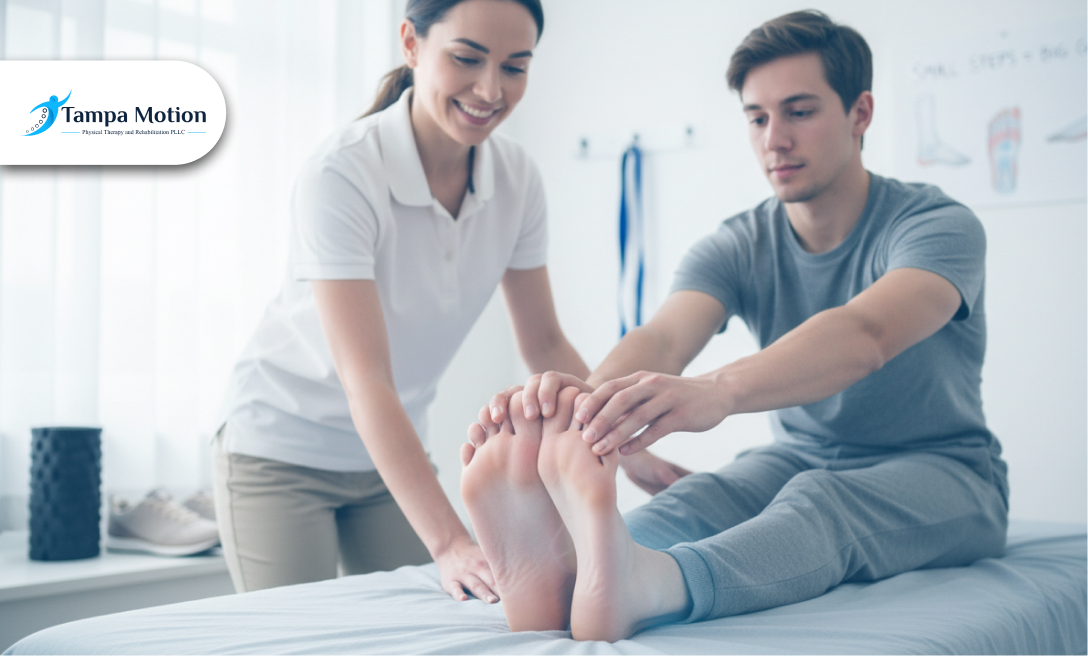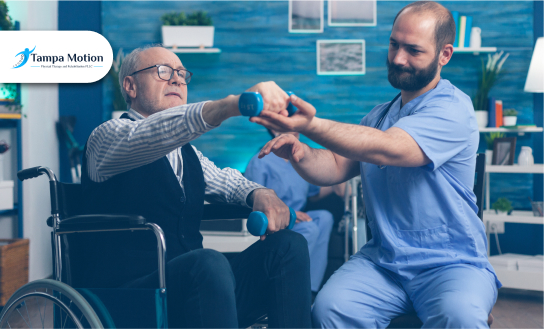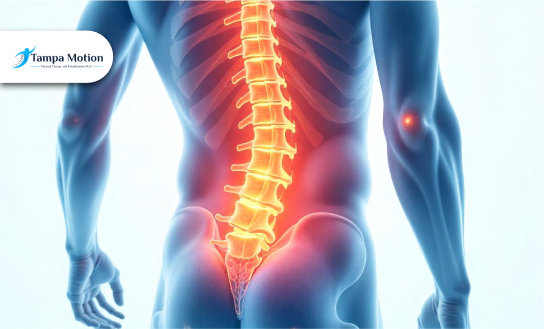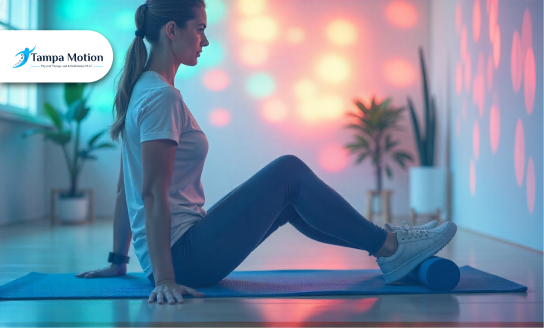
Physical Therapy for Vertigo: What Works
October 7, 2025
Physical Therapy for Vertigo: What Works
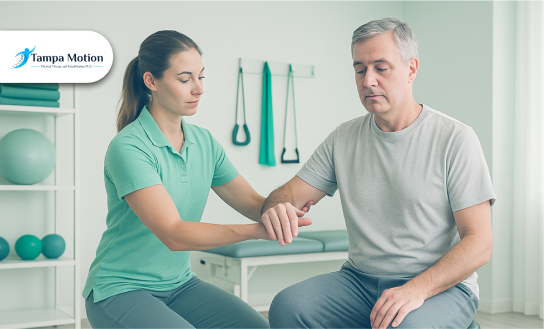
Nearly 40 percent of U.S. adults will experience vertigo at some point in their lives, according to the National Institutes of Health. A figure that shows how common and how disruptive it can be. In Tampa, where life moves in motion. Your sickness can turn the vibrant rhythm of your life into sudden, unsettling chaos. One step becomes cautious, one turn unbalanced, and even familiar motions feel uncertain.
For many locals, vertigo is a barrier to work, weekend plans, and the simple pleasure of moving without fear. However, what if the key to recovery lies not in pills or scans, rather in retraining the body’s own sense of balance? The answer may surprise you.
1) Vertigo, More Common Than You Think
Vertigo isn’t a rare quirk and is surprisingly widespread. It’s a sensation of your world spinning even when you’re perfectly still, often paired with nausea or unsteadiness. It’s disorienting and deeply unpleasant, and that kind of imbalance can hit hard.
Roughly 20 to 40 percent of adults will experience dizziness or vertigo at some point in their lives. In any given year, about 5 percent of people contend with vertigo, and incidence increases as one gets older, particularly after forty, according to Medscape.
More striking still, more than 20 percent of adults report dizziness or imbalance annually, and as many as 40 percent of those over 40 face it. These aren’t statistics, they’re reminders that vertigo quietly interrupts the lives of many around us.
Unfortunately, vertigo doesn’t keep a calendar. At Tampa Motion, therapists see cases year-round. Many follow boating mishaps, weekend sports injuries, or seasonal sinus flare-ups that trigger inner-ear imbalance. When humidity rises and allergy season arrives, even harmless pollen can throw the seaside jogger off balance.
2) The Science Behind Physical Therapy for Vertigo

When your head tilts, turns, or accelerates, hidden miracles happen inside your ear. Your vestibular system senses rotation and motion and sends that data straight to your brain. There, it partners with your eyes and muscles to align sight and movement, keeping you upright in a fast-moving life.
However, when that system falters, everyday actions like mounting a paddleboard or turning in traffic can feel unsteady. That’s where physical therapy steps in, transforming disorientation into dynamic recovery.
First up is the Epley maneuver, a deft repositioning treatment. According to the National Institute of Health (NIH), more than 1 in 20 (nearly 3.3 million) children between the ages of 3 and 17 have a dizziness or balance problem in U.S. children.
And as per numerous studies and systematic reviews published on the National Library of Medicine's database (PubMed), the Epley maneuver is recognized as a safe and highly effective treatment for benign paroxysmal positional vertigo (BPPV).
In most cases, one treatment resolves symptoms for 80–90 percent of patients, and a second brings relief to nearly all.
Then comes Vestibular Rehabilitation Therapy (VRT), a suite of exercises that pushes your body’s natural adaptation mechanisms. By repeating specific eye, head, and body movements, your brain learns to recalibrate and compensate. Studies show VRT significantly reduces dizziness, lowers fall risk, and improves balance even for patients with persistent vestibular deficits.
Gaze stabilization exercises are another key. Executed under expert guidance, these help your eyes lock on a target while your head moves—retraining the brain’s coordination so you’re not thrown off when you're walking on a crowded Tampa trail or riding a wave at sunset.
Finally, the real world comes into the training room through balance simulations by standing on foam, closing your eyes, or balancing on unpredictability. They force your brain to rely on vision, touch, and proprioception in new ways, building resilient balance skills that stick.
What unites these treatments is a vital truth. We are not hiding the vertigo’s condition; we retrain your brain and body, which promotes long-term balance. You’re getting relief as well as learning to trust your world again. That trust and confidence matter.
3) Tampa Motion’s Proven Approach
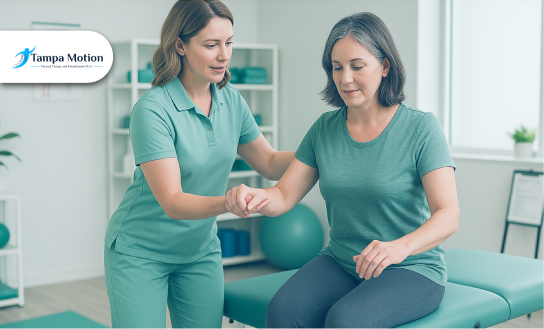
In a city built on movement, Tampa Motion has earned its reputation as the place locals turn to when vertigo threatens to derail their lives. Their formula blends clinical precision with human warmth, creating treatment plans that feel as individual as the people they serve.
Tampa Motion stands out because of :
Specialized Training: All therapists are highly skilled in vestibular rehabilitation, using the latest research and proven protocols.
Track Record of Results: Hundreds of Tampa patients have returned to activities they once thought were out of reach.
Personalized Care: Every plan is custom-built, considering lifestyle, goals, and unique health needs.
Our Treatment That Fits Real Life:
In-office sessions for guided progress and real-time adjustments.
At-home exercises suitable for everyday routines, from quick balance checks in the kitchen to eye-head coordination drills before a morning walk.
Flexible programs that adapt as symptoms improve, ensuring gains are permanent.
The result is more than symptom relief. It’s a full return to your active lifestyle. Our treatment plan is grounded in science and built for long-term confidence.
Next, we’ll look at the lifestyle strategies that make these results last, no matter the season or setting.
4) Our Support About Lifestyle for Lasting Results
Staying balanced goes beyond therapy. Tampa Motion builds long-term steadiness by blending personalized care with smart, lifestyle-savvy coaching.
(I) Tips that actually make a difference:
Stay Hydrated in the Heat: Dehydration can worsen vertigo, and in the humid Florida climate, it’s a hidden risk. Even mild dehydration can contribute to vestibular imbalances, making proper fluid intake essential for maintaining equilibrium.
Manage Allergy Season and Sinus Health: Pollen and seasonal allergies can inflame the sinuses and disrupt ear pressure, triggering vertigo. Tampa Motion encourages sinus hygiene with saline rinses, nasal sprays, and allergen avoidance.
Practice Safe Boating and Water Sports Habits: It’s important to prevent motion-related triggers. Experts recommend staying hydrated, avoiding alcohol, choosing mid-ship positions on boats, and keeping your gaze on the horizon to reduce sensory conflict.
(II) How Tampa Motion weaves these habits into recovery:
Therapists coach patients on daily rituals. From balancing hydration levels to choosing activities during high-pollen days to reduce flare-ups outside the clinic.
Personalized “vertigo-first” routines ensure that whether heading out for a morning paddle or navigating Ybor City, you move with more confidence and less risk.
Insightful reminders like carrying a water bottle, checking pollen counts, or scanning for sinus-friendly meals can turn good intentions into habits.
With this lifestyle foundation, relief continues after the appointment. It is present throughout your active days and vibrant nights.
Next, we’ll explore why early intervention is more than helpful. It’s essential to avoid a spiral of falls, fear, and missed opportunities.
5) Why Early Intervention Matters

Ignoring recurring vertigo can be dangerous. When dizziness becomes a regular companion, the risks escalate quickly.
Increased Fall Risk: Vertigo can cause disorientation, leading to falls. In older adults, falls are a leading cause of injury and death.
Loss of Independence: Fear of falling often leads to reduced activity, which can result in muscle weakness and further balance issues.
Prolonged Discomfort: Without treatment, vertigo can persist, affecting daily life and mental health.
Early physical therapy, particularly Vestibular Rehabilitation Therapy (VRT), offers significant benefits:
Shorter Recovery Time: Starting therapy early can reduce the duration of symptoms and improve outcomes.
Habituate the brain: Vertigo is often triggered by certain movements. VRT includes controlled, repeated exposure to these movements, which gradually desensitizes your brain and reduces the intensity of the dizzy spells.
Improved Quality of Life: VRT can alleviate dizziness, enhance balance, and reduce the risk of falls.
Reduces dizziness and enhances balance: The exercises in VRT are designed to improve your gaze stabilization. That means the ability to keep your eyes focused on a target while your head is moving and also postural control (the ability to maintain your balance). These skills are essential for daily activities like walking, reading, and driving.
Reduces the risk of falls: With improved balance and stability, you can navigate your environment more confidently and with less risk of falling, which is a major concern for people with chronic dizziness. This can be especially life-changing for older adults.
Breaks the cycle of anxiety and avoidance: Many people with vertigo develop anxiety and a fear of falling or triggering a dizzy spell. This leads to them avoiding social outings, exercise, and other activities they once enjoyed.
VRT helps you regain control over your body, which in turn rebuilds your confidence and reduces this cycle of avoidance.
6) Take the First Step Toward Lasting Vertigo Relief in Tampa
Living with vertigo can feel isolating and frustrating. Where an active lifestyle is cherished, seeking early treatment at Tampa Motion can help you regain your balance and confidence. This is ensuring you continue to enjoy everything. If you have any questions or concerns, don’t hesitate to reach out. Let’s talk directly at +1 813-291-3536 or email athena.akram@tampamotion.com for timely, friendly answers.
For your convenience. Tampa Motion is located at 8333 Gunn Highway, Tampa, FL 33626, easy to access from anywhere in the area. Do you prefer online? Fill out our simple contact form on tampamotion.com/contact, and our team will get back to you as soon as possible to schedule your personalized assessment.
Recent Blogs

